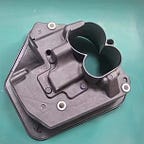In the realm of metalworking and precision manufacturing, metal mills and CNC (Computer Numerical Control) machines play crucial yet distinct roles. Both are indispensable tools in the creation of metal components and products, but they differ significantly in their operation, capabilities, and intended applications. This article aims to provide a professional analysis of the key differences between metal mills and CNC machines.
1. Operation and Control
The fundamental difference between metal mills and CNC machines lies in their operation and control mechanisms. Metal mills, such as rolling mills or forging mills, rely on mechanical or hydraulic power to shape and deform metal. These mills often require human operators to manually adjust and control the equipment based on their experience and judgment.
On the other hand, metal CNC machines are computerized and operate under precise numerical control. They are programmed with computer-aided design (CAD) software to create a virtual model of the desired part, and then the machine automatically converts these designs into cutting instructions. CNC machines eliminate the need for manual operation, ensuring consistency and accuracy in the manufacturing process.
2. Capabilities and Precision
Metal mills are capable of handling large volumes of metal and are often used in the initial stages of metalworking, such as rolling sheets or bars into specific shapes and sizes. While they can achieve a certain level of accuracy, their precision is often limited by the capabilities of the operator and the mechanical constraints of the equipment.
CNC machines, on the other hand, excel in precision and repeatability. They can cut and shape metal with extreme accuracy, often down to fractions of a millimeter. CNC machines are capable of handling complex geometries and intricate details that would be difficult or impossible to achieve with traditional metal mills.
3. Flexibility and Versatility
Metal mills tend to be more specialized and limited in their applications. They are designed to perform specific tasks, such as rolling, forging, or extruding metal, and are not easily adaptable to different processes or materials.
CNC machines, however, offer a high level of flexibility and versatility. They can be programmed to perform a wide range of tasks, from simple drilling and cutting to complex milling and turning operations. CNC machines can also be easily adapted to handle different materials, including metals, plastics, and composites.
4. Cost and Efficiency
Metal mills are often more cost-effective for large-scale production runs of simple components. They require less upfront investment and can operate continuously with minimal operator intervention. However, they may be less efficient for small-batch or customized production, where the setup time and operator expertise can become significant factors.
CNC machines, while initially more expensive, offer higher efficiency and productivity in the long run. They eliminate the need for manual setup and adjustment, reducing operator error and improving consistency. CNC machines are also capable of operating unattended for extended periods, maximizing production capacity.
In conclusion, metal mills and CNC machines are both valuable tools in the metalworking and manufacturing industries, but they differ significantly in their operation, capabilities, and intended applications. Metal mills excel in handling large volumes of metal and achieving a certain level of accuracy, while CNC machines offer unparalleled precision, flexibility, and efficiency in the manufacturing process. Understanding these differences is crucial for selecting the right equipment for your specific needs.
